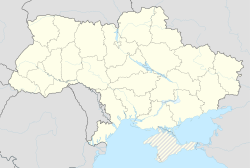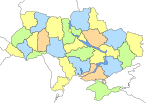Odessa
| Odessa Одесса (tiếng Nga) Одеса (tiếng Ukraina) | |
|---|---|
 Theo ngược chiều kim đồng hồ: Đài tưởng niệm Duc de Richelieu, hải đăng Vorontsov, vườn thành phố, Nhà hát Opera và Ballet Odessa, bậc thềm Potemkin, Square de Richelieu | |
 | |
| Quốc gia | |
| Oblast | |
| Lập cảng | 2 tháng 9, 1794 |
| Đặt tên theo | Odessos |
| Diện tích | |
| • Tổng cộng | 236,9 km2 (91,5 mi2) |
| Độ cao | 40 m (130 ft) |
| Độ cao cực đại | 65 m (213 ft) |
| Độ cao cực tiểu | −4,2 m (−138 ft) |
| Dân số (2015) | |
| • Tổng cộng | 1.016.515 |
| • Mật độ | 4,300/km2 (11,000/mi2) |
| Tên cư dân | tiếng Anh: Odessite tiếng Ukraina: одесит, одеситка |
| Múi giờ | UTC+3, UTC+2, Giờ Đông Âu |
| • Mùa hè (DST) | EEST (UTC+3) |
| Postal code | 65000–65480 |
| Mã điện thoại | 048 |
| Thành phố kết nghĩa | Tbilisi |
| Website | www.omr.gov.ua/en/ |
Odessa (còn gọi là Odesa; tiếng Ukraina: Оде́са [ɔˈdɛsɐ]; tiếng Nga: Оде́сса [ɐˈdʲesə]; tiếng Yid: אַדעס) là thành phố đông dân thứ ba Ukraina và là một trung tâm du lịch, thương mại và vận tải lớn nằm trên bờ tây bắc biển Đen. Đây là thủ phủ oblast Odessa. Odessa có khi được mệnh danh là "hòn ngọc biển Đen",[1] "Nam Đô" (dưới thời Đế quốc Nga và Liên Xô), và "Nam Palmyra". Trước khi lọt vào tay Sa hoàng, từng có một khu người Hy Lạp nơi đây (người Hy Lạp cũng sống rải rác khắp bờ bắc biển Đen). Rồi đến người Tatar, theo chân Hacı I Giray - Hãn của Krym, đến định cư nơi này năm 1440, đặt cho nó cái tên "Hacıbey".[2] Sau một thời nằm dưới Đại công quốc Lietuva, Hacibey rơi vào tay người Ottoman từ 1529 cho tới khi đế quốc Ottoman bị đánh bại trong chiến tranh Nga-Thổ Nhĩ Kỳ năm 1792.
Năm 1794, thành phố Odessa được lập nên theo chỉ thị của Ekaterina Đại đế, nữ hoàng Nga. Từ năm 1819 đến 1858, Odessa là một hải cảng tự do. Vào thời Liên Xô, đây là một cảng thương mại kiêm căn cứ hải quân quan trọng.
Hồi thế kỷ XIX, Odessa là thành phố lớn thứ 4 Đế quốc Nga, sau Moskva, Sankt-Peterburg và Warszawa.[3] Kiến trúc lịch sử nơi đây mang đậm nét Địa Trung Hải hơn nét Nga, do chịu ảnh hưởng nặng phong cách Pháp, Ý. Một số tòa nhà là sự pha trộn đa phong cách, gồm Art Nouveau, Phục hưng và Cổ điển.[4]
Địa lý
[sửa | sửa mã nguồn]Khí hậu
[sửa | sửa mã nguồn]Odessa có khí hậu lục địa ẩm (phân loại khí hậu Köppen Dfa), giáp với khí hậu bán khô hạn và cận nhiệt đới ẩm.
| Dữ liệu khí hậu của Odessa | |||||||||||||
|---|---|---|---|---|---|---|---|---|---|---|---|---|---|
| Tháng | 1 | 2 | 3 | 4 | 5 | 6 | 7 | 8 | 9 | 10 | 11 | 12 | Năm |
| Cao kỉ lục °C (°F) | 15.1 (59.2) |
19.2 (66.6) |
24.1 (75.4) |
29.4 (84.9) |
33.3 (91.9) |
37.2 (99.0) |
39.3 (102.7) |
38.0 (100.4) |
35.4 (95.7) |
30.5 (86.9) |
26.0 (78.8) |
16.9 (62.4) |
39.3 (102.7) |
| Trung bình ngày tối đa °C (°F) | 2.3 (36.1) |
3.4 (38.1) |
7.7 (45.9) |
13.6 (56.5) |
20.3 (68.5) |
25.1 (77.2) |
27.9 (82.2) |
27.7 (81.9) |
21.8 (71.2) |
15.3 (59.5) |
9.1 (48.4) |
4.2 (39.6) |
14.9 (58.8) |
| Trung bình ngày °C (°F) | −0.4 (31.3) |
0.4 (32.7) |
4.3 (39.7) |
10.0 (50.0) |
16.2 (61.2) |
20.8 (69.4) |
23.4 (74.1) |
23.1 (73.6) |
17.8 (64.0) |
12.0 (53.6) |
6.3 (43.3) |
1.5 (34.7) |
11.3 (52.3) |
| Tối thiểu trung bình ngày °C (°F) | −2.7 (27.1) |
−2.1 (28.2) |
1.6 (34.9) |
6.9 (44.4) |
12.6 (54.7) |
16.9 (62.4) |
19.1 (66.4) |
18.5 (65.3) |
14.0 (57.2) |
8.9 (48.0) |
3.9 (39.0) |
−0.8 (30.6) |
8.1 (46.6) |
| Thấp kỉ lục °C (°F) | −26.2 (−15.2) |
−28.0 (−18.4) |
−16.0 (3.2) |
−5.9 (21.4) |
0.3 (32.5) |
5.2 (41.4) |
7.5 (45.5) |
7.9 (46.2) |
−0.8 (30.6) |
−13.3 (8.1) |
−14.6 (5.7) |
−19.6 (−3.3) |
−28.0 (−18.4) |
| Lượng Giáng thủy trung bình mm (inches) | 43 (1.7) |
35 (1.4) |
35 (1.4) |
28 (1.1) |
39 (1.5) |
47 (1.9) |
45 (1.8) |
40 (1.6) |
44 (1.7) |
37 (1.5) |
39 (1.5) |
38 (1.5) |
470 (18.5) |
| Số ngày mưa trung bình | 9 | 7 | 10 | 11 | 12 | 13 | 10 | 8 | 9 | 10 | 13 | 10 | 122 |
| Số ngày tuyết rơi trung bình | 11 | 10 | 6 | 0.4 | 0 | 0 | 0 | 0 | 0 | 0.2 | 4 | 9 | 41 |
| Độ ẩm tương đối trung bình (%) | 82.5 | 80.7 | 78.4 | 74.5 | 71.0 | 70.6 | 66.0 | 65.4 | 71.8 | 77.1 | 81.9 | 83.6 | 75.3 |
| Số giờ nắng trung bình tháng | 63.2 | 91.6 | 142.2 | 199.5 | 292.5 | 307.5 | 332.9 | 313.1 | 234.6 | 164.7 | 73.0 | 57.4 | 2.272,2 |
| Nguồn 1: Pogoda.ru[5] | |||||||||||||
| Nguồn 2: Tổ chức Khí tượng Thế giới [6] | |||||||||||||
Chú thích
[sửa | sửa mã nguồn]- ^ “Who's Behind A String Of Bombings In Ukraine's Black Sea 'Pearl'?”. NPR. 2015. Truy cập ngày 7 tháng 7 năm 2016.
- ^ Pultar, Gonul. Imagined Identities: Identity Formation in the Age of Globalization, tr. 355, tại Google Books
- ^ Herlihy, Patricia (1977). “The Ethnic Composition of the City of Odessa in the Nineteenth Century” (PDF). Harvard Ukrainian Studies. 1 (1): 53–78. Bản gốc (PDF) lưu trữ ngày 29 tháng 5 năm 2008.
- ^ “Odessa: Architecture and Monuments”. UKRWorld.Com. 2009. Bản gốc lưu trữ ngày 6 tháng 3 năm 2012. Truy cập ngày 9 tháng 6 năm 2009.
- ^ Погода и Климат – Климат Одессы [Weather and Climate – The Climate of Odessa] (bằng tiếng Nga). Weather and Climate (Погода и климат). Truy cập ngày 8 tháng 11 năm 2021.
- ^ “World Meteorological Organization Climate Normals for 1981–2010”. World Meteorological Organization. Bản gốc lưu trữ ngày 17 tháng 7 năm 2021. Truy cập ngày 17 tháng 7 năm 2021.
Tài liệu
[sửa | sửa mã nguồn]- Richardson, Tanya (2008). Kaleidoscopic Odessa: History and Place in Contemporary Ukraine. University of Toronto Press. ISBN 0-8020-9563-1. Truy cập ngày 7 tháng 11 năm 2009.
Đọc thêm
[sửa | sửa mã nguồn]- Dallin, Alexander (1998). Odessa, 1941–1944: A Case Study of Soviet Territory Under Foreign Rule. Iaşi: Center for Romanian Studies. ISBN 973-98391-1-8. Bản gốc lưu trữ ngày 5 tháng 2 năm 2012. Truy cập ngày 7 tháng 11 năm 2009. Complete book available online.
- Friedberg, Maurice (1991). How Things Were Done in Odessa: Cultural and Intellectual Pursuits in a Soviet City. Boulder, CO: Westview Press. ISBN 0-8133-7987-3. Two reviews Lưu trữ 2022-06-29 tại Wayback Machine
- Ghervas, Stella (2008). “Odessa et les confins de l'Europe: un éclairage historique”. Trong Ghervas, Stella; Rosset, François (biên tập). Lieux d'Europe. Mythes et limites. Paris: Editions de la Maison des sciences de l'homme. ISBN 978-2-7351-1182-4.
- Ghervas, Stella (2008). Réinventer la tradition. Alexandre Stourdza et l'Europe de la Sainte-Alliance. Paris: Honoré Champion. ISBN 978-2-7453-1669-1.
- Gubar, Oleg (2004). Odessa: New Monuments, Memorial Plaques, and Buildings. Odessa: Optimum. ISBN 966-8072-86-3.
- Herlihy, Patricia (1979–1980). “Greek Merchants in Odessa in the Nineteenth Century” (PDF). Harvard Ukrainian Studies. tr. 399–420. Bản gốc (PDF) lưu trữ ngày 29 tháng 5 năm 2008.
- Herlihy, Patricia (1987). Odessa: A History, 1794–1914. Cambridge, MA: Harvard University Press. ISBN 0-916458-15-6. (hardcover), ISBN 0-916458-43-1 (1991 paperback reprint)
- Herlihy, Patricia (2002). “Commerce and Architecture in Odessa in Late Imperial Russia”. Commerce in Russian Urban Culture 1861–1914. Baltimore: Johns Hopkins University Press. ISBN 0-8018-6750-9.
- Herlihy, Patricia (2003). “Port Jews of Odessa and Trieste: A Tale of Two Cities”. Jahrbuch des Simon-Dubnow-Instituts. München: Deutsche Verlags-Anstalt. 2: 182–198. ISBN 3-421-05522-X.
- Herlihy, Patricia; Gubar, Oleg (2008). “The Persuasive Power of the Odessa Myth”. Trong Czaplicka, John; Gelazis, Nida; Ruble, Blair A. (biên tập). Cities after the Fall of Communism: Reshaping Cultural Landscapes and European Identity. Woodrow Wilson Center Press and Johns Hopkins University Press. ISBN 978-0-8018-9191-5.
- Kaufman, Bel; Oleg Gubar (Contributor), Alexander Rozenboim (Contributor), Nicholas V. Iljine (Editor), Patricia Herlihy (Editor) (2004). Odessa Memories. Seattle: University of Washington Press. ISBN 0-295-98345-0.Quản lý CS1: nhiều tên: danh sách tác giả (liên kết) Quản lý CS1: văn bản dư: danh sách tác giả (liên kết)
- King, Charles (2011). Odessa: Genius and Death in a City of Dreams. W. W. Norton & Company. ISBN 978-0-393-07084-2.
- Kononova, G. (1984). Odessa: A Guide. Moscow: Raduga Publishers. OCLC 12344892.
- Makolkin, Anna (2004). A History of Odessa, the Last Italian Black Sea Colony. Lewiston, NY: Edwin Mellen Press. ISBN 0-7734-6272-4.
- Mazis, John Athanasios (2004). The Greeks of Odessa: Diaspora Leadership in Late Imperial Russia. East European Monographs. New York: Columbia University Press. ISBN 0-88033-545-9.
- Orbach, Alexander (1997). New Voices of Russian Jewry: A Study of the Russian-Jewish Press of Odessa in the Era of the Great Reforms, 1860–1871. Studies in Judaism in Modern Times, No. 4. Leiden: Brill Academic Publishers. ISBN 90-04-06175-4.
- Rothstein, Robert A. (2001). “How It Was Sung in Odessa: At the Intersection of Russian and Yiddish Folk Culture”. Slavic Review. 60 (4): 781–801. doi:10.2307/2697495. JSTOR 2697495.
- Skinner, Frederick W. (1986). “Odessa and the Problem of Urban Modernization”. The City in Late Imperial Russia. Indiana–Michigan Series in Russian and East European Studies. Bloomington, Indiana: Indiana University Press. ISBN 0-253-31370-8.
- Sylvester, Roshanna P. (2001). “City of Thieves: Moldavanka, Criminality, and Respectability in Prerevolutionary Odessa”. Journal of Urban History. 27 (2): 131–157. doi:10.1177/009614420102700201. PMID 18333319.
- Tanny, Jarrod (2011). City of Rogues and Schnorrers: Russia’s Jews and the Myth of Old Odessa. Bloomington, IN: Indiana University Press. ISBN 978-0-253-35646-8. (hardcover); ISBN 978-0-253-22328-9 (paperback)
- Weinberg, Robert (1992). “The Pogrom of 1905 in Odessa: A Case Study”. Pogroms: Anti-Jewish Violence in Modern Russian History. Cambridge: Cambridge University Press. ISBN 0-521-40532-7.
- Weinberg, Robert (1993). The Revolution of 1905 in Odessa: Blood on the Steps. Indiana–Michigan Series in Russian and East European Studies. Bloomington, IN: Indiana University Press. ISBN 0-253-36381-0.
- Herlihy, Patricia (1994). “Review of The Revolution of 1905 in Odessa: Blood on the Steps by Robert Weinberg”. Journal of Social History. 28 (2): 435–437. doi:10.1353/jsh/28.2.435. JSTOR 3788930.
- Zipperstein, Steven J. (1991) [1986]. The Jews of Odessa: A Cultural History, 1794–1881. Palo Alto: Stanford University Press. ISBN 0-8047-1251-4. (hardcover), ISBN 0-8047-1962-4 (paperback reprint)
 GIẢM
19%
GIẢM
19%
 GIẢM
17%
GIẢM
17%
 GIẢM
13%
GIẢM
13%
![[Review sách] Bay trên tổ cúc cu - Ken Kesey](https://down-tx-vn.img.susercontent.com/079e668073f965ecde883224be898386.webp) GIẢM
20%
GIẢM
20%






![[Tóm tắt và đánh giá] Bạn không thông minh lắm đâu | Cuốn sách tâm lý học thú vị bạn nên đọc vào năm 2024](https://down-bs-vn.img.susercontent.com/vn-11134201-23030-c1d4ivny4kov19.webp)
![[Genshin Impact] Bi kịch nhà Ragnvindr](https://besthqwallpapers.com/Uploads/9-5-2021/167191/thumb2-4k-diluc-rain-genshin-impact-protagonists.jpg)


